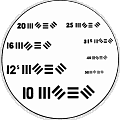RESOLUTION
|
|
|
-
- Definition:
- The resolution is the size of the smallest detail that
an imager can show.
-
- The resolution is a physical
quantity
- Note also that it is a linear value.
-
|
|
- Measuring resolution is done on a test pattern drawn
with lines of equal thickness alternatively white and black,
as the keys of a piano.
- The resolution is equal to the step of the target lines,
which is the width of a pair of lines, a white and a black
one.
-
|

|
|
Opposite, a typical target of a
test pattern.
Modulation transfer
function:
The measurements of resolution
have been improved to take in account the complexity of
phenomenon such as acutance, spacial interferences, and
contrast of colors. The measures of the Modulation Transfer
Function, or MTF, also based on test patterns of alternating
lines are now commonly used.
|
Resolving power:
- The resolving power is the inverse of the resolution
for a unit of length. Therefore, it is the number of pairs
of lines in the unit of length.
|
|
The resolving power is usually given
in number of pairs of lines per mm [pl/mm] or cycles per
mm [cy/mm]. It is the same than counting the black lines
only.
A resolving power of 80 pl/mm is equivalent
to a resolution of 0,0125mm.
|
Relation resolution
<?> circle of confusion:
Most of the time, the photographers
get the habit to apply résolution = circle of
confusion. But it is not equal.
Have two dots which are the width
of a line of the pattern. To discriminate them, it must
be offset of half the width according to the circle of confusion
definition, whilst with the resolution it could be guessed
that it would be sufficient to place them side by side.
Moreover, on a film it is possible to offset of half a value,
but on digital patterns, it will be necessarily of an entire
value.
To make it short, use the resolution
as equivalent to the circle of confusion, is like saying
that c = 2,5 ~ 2 on a film, and c=2,5 ~ 3 in digital.
|
|
The theoretical error when assimilating
the resolution to the circle of confusion is 25% on a film
and 50% for digital.
Above, I mentioned that I use the
0,0004 for visual acuity rather than the ophtalmologist
value of 0,0003. The difference is 33% which is between
the errors percentage. Therefore, the 0,0004 value is between
the correct values of film and digital.
The equivalence
circle of confusion
= resolution is acceptable
with a visual acuity a=0,0004
c
= 1.25 r
|
